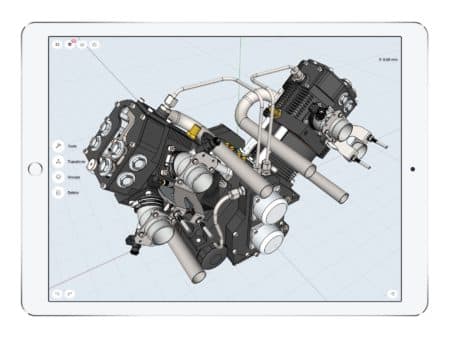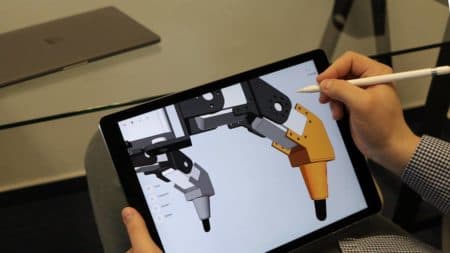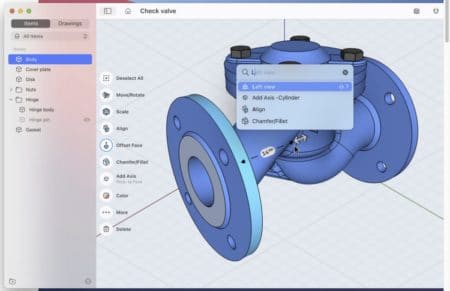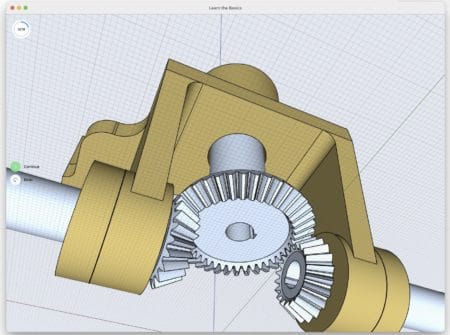IT HAS BEEN OVER A YEAR AND A HALF SINCE WE HAVE LAST SPOKEN WITH ISTVAN CSANADY. His innovative design and CAD application, written exclusively for the iPad Pro, shook up the MCAD market when it arrived a few years ago. Not just that, it also proudly boasted of what was possible on Apple’s tablet platform and what could be possible someday on the Mac platform if it ever moved over to the same hardware architecture. That day, of course, has arrived.
Award Winner App
Before discussing Shapr3D’s path to the new Apple Silicon Macs, it is essential to point out the star-like trajectory of the 3D application itself. The app has won the coveted Apple Design Award at the 2020 Apple Worldwide Developers Conference. “That is a tremendous honor,” says Csanady, “because it is super competitive to win that award.” In fact, out of two and a half million apps in the Apple App Store, only about five to ten win this great honor.
The biggest problem with CAD—with the legacy solutions—is it is tough to buy, very hard to use, and it is essentially unchanged for the last 30 years.
Another remarkable fact that Csanady shared with me on our call is that it has over 16,000 paying customers. “It’s pretty cool if you consider that OnShape had 5,000 paying customers,” says Csanady, referring to the Boston-based CAD company acquired in 2019 by Parametric Technology Corporation (PTC), also of Metro Boston.
The Transformation of CAD
And it took Shapr3D vastly less time to acquire so many customers than the acquisition of the web-based CAD upstart OnShape. “I think we are probably the fastest growing CAD system since SolidWorks, adds Csanady, “which is really quite remarkable considering we have only been available on the Apple iPad Pro.”
And Shapr3D’s success and significant numbers of customers isn’t some “halo effect” of being on a popular Apple device either. If that were the case, if Apple had that kind of power, you would see vastly more CAD applications from the Windows world come on over to Apple’s platforms. Instead, Shapr3D is tapping into some unmet needs not envisioned by the CAD industry’s incumbent leaders.

01 – Shapr3D is a relatively new and powerful product design and CAD tool exclusively for the Apple iPad Pro with Apple Pencil, and now also for Apple Macs that are ARM-based computers—which will be all Mac computers in the next few years.
“Our success is that we are solving a real customer problem,” he injects. “If you look at Shapr3D, it’s really aggressive. The biggest problem with CAD—with the legacy solutions—is it is tough to buy, very hard to use, and it is essentially unchanged for the last 30 years.”
I asked Csanady to unpack those comments a bit because it seems so trite to characterize the CAD industry in those terms. “It means the CAD tools being used today were all designed for the needs of the 1990s,” he shoots back. “Literally, everything has changed since then, from how we collaborate to how we think about design, and the computers themselves have changed.”
The Computers Are Changing
Csanady doesn’t think that desktops or workstations no longer matter, but our conversation did reveal an apt metaphor. “I am not saying they will completely disappear,” he notes. “The question is: what type of computers will be our primary devices?”
“We still need mainframe computers even today, but how many people go on mainframe computers to use CAD, which was not the case in the early 1980s? We believe a very similar transition is going to happen with this platform switch,” essentially saying tablets and smartphones are to personal computers what the personal computer was to the mainframe.
Shapr3D has capitalized on the tablet’s success—specifically Apple iPad Pro with its Apple Pencil. Both the iPad Pro and the Apple Pencil have been required for Shapr3D. “It’s definitely a part of it,” he adds. “People actually switch completely to tablets and even mobile phones. It is not just that, but the ease of use these devices provide is incomparable to traditional desktop computers. Ease of use and user experience is actually quite foundational nowadays in how people use software.”

02 – Shapr3D for the iPad Pro has impressive capabilities and have generated a rapid professional user-based of users from all over the world. Shapr3D is the fastest growing CAD software since SolidWorks, says its CEO.
I suggest to Csanady that it was “ease of use” that empowered SketchUp’s meteoric rise to app stardom two decades ago. After SolidWork’s rapid rise, then came SketchUp. “We admire SketchUp…very great tool. Shapr3D is SketchUp on steroids because it’s a solid modeler with very similar ease of use,” he adds, “and the quality of the models is much higher. You can directly manufacturer your models and designs from Shapr3D, which is not the case with Sketchup.”
Shapr3D — Rising Power Tool
Shapr3D began as a serious CAD tool. And it has advanced in lock-step with Apple’s iPad OS and its new capabilities, like multi-windowing. Customers also use a tethered Mac (iPad is actually tethered to the Mac) as a second monitor, but the iPad is the primary design interface.
Customers want the larger screen on the Mac because of their specific workflows. Some Shapr3D customers are designing very large models and assemblies. “We are always blown away to see our customers building substantial things,” he says.
On the iPad Pro, Shapr3D tends to be faster for most modeling operations using Parasolid than other desktop computers. We are super happy with Parasolid.
To keep up with advancements, in 2020, Shapr3D introduced a new user interface called AdaptiveUI. “It is a new way to access the modeling tools that give you automatic suggestions for your next modeling operations,” he says, noting that for some customers, they are getting a 30 percent faster boost in modeling times. “We have benchmarks comparing previous versions of Shapr3D where we often see 2-3 percent increases in faster modeling, so a 30 percent increase is absolutely mind-blowing.”
Shapr3D is powered by Siemens’s Parasolid geometry modeling kernel, considered the gold standard in the MCAD world. When Siemens decided to port Parasolid to Apple’s iOS a few years ago, it took them about 6-9 months. “iOS was a harder port but not our hardest,” says Phil Nanson, Manager, Parasolid Components, Siemens PLM Software. “Most of our challenges were in testing rather than getting Parasolid to run,” he adds.

03 – Shapr3D on ARM-based Macs is the newest development for the award-winning CAD software company. Csanady is also very bullish on Apple Silicon and what Apple’s semiconductor design leadership will mean for both Apple’s mobile devices and its new ARM-based Macs.
With Parasolid on iOS, Shapr3D had one of the significant critical pieces in place so the Shapr3D development team could focus on the unique selling points of the CAD software. A big part of that is leveraging Apple’s iPad Pro and Pencil user-experience paradigm.
Of course, Apple’s chip development in its iPad Pro has also been incredible, enabling Shapr3D users to take on larger and larger models. “On the iPad Pro, Shapr3D tends to be faster for most modeling operations using Parasolid than other desktop computers. We are super happy with Parasolid,” says Csanady. He is also pleased with Apple’s progress with their iPads, particularly important given that he built his company around that platform. “In the last 10 years, they have gotten 1000x faster,” he says. “It’s stunning to think about the performance curve Apple has achieved with its silicon design teams.”
Moving to Apple Silicon Macs
When Apple introduced its chip transition to ARM-based Apple Silicon, it suddenly became apparent that iOS apps would make natural candidates for migration to macOS.
Csanady was enthusiastic about the transition, and it meant Shapr3D would be coming to the Mac. It wasn’t just that his company got another target operating system for truly minimal effort in coding; he was excited about Apple Silicon’s potential.

04 – Shapr3D screenshot of the introductory learning process when one launches the Mac version of Shapr3D. The award-winning software is very intuitive—just as intuitive as SketchUp—but fundamentally the application is very different because it utilizes the most powerful industrial-class modeling kernel in the world, Parasolid.
“I’m super enthusiastic,” he adds. “If you look at the performance improvements, it is something we haven’t seen for two decades. I strongly believe that this new architecture is a game-changer, especially for pro users.”
Csanady says that what is unique about Apple’s chip designs is they are capable of so much customization carried up from silicon to their operating system technologies. This gives the company an added edge against Intel and AMD, who have lost the single-core performance crown to the new Macs’ Apple M1 chip. “The architecture in the chips allows them to build a lot of specific improvements to the core CPU efficiently that will do certain tasks 100x to 1000x faster,” he says. “CAD can benefit from this since it relies on large matrix modifications and doing lots of floating-point operations in parallel.”
If you look at the performance improvements, it is something we haven’t seen for two decades. I strongly believe that this new architecture is a game-changer, especially for pro users.
But getting the Apple Silicon version of Shapr3D ready also meant that Siemens needed to port their existent Mac Parasolid kerne to Apple’s ARM architecture. Last summer, Phil Nanson told us that Siemens was receiving their Mac mini M1 test machines in the summer. We knew from Nanson that with both iOS and Intel Mac versions in hand, the port to Apple Silicon would go quickly.
Indeed, Shapr3D on Apple Silicon Macs is now here and ready to download, and the performance Csanady says is quite astonishing. “We’ve measured up to 2-3x faster CPU performance increase and a 7x performance increase compared to Intel-based devices,” he says. “It’s absolutely amazing.”
CAD Dominance for Shapr3D
The question that comes to mind is can a relatively new software company rise to CAD dominance?
When disruptors displace incumbent market leaders, they emerge from below and outside; they don’t initially get into the same market as the incumbents they will potentially overtake. Shapr3D started on a tablet platform, so they check off this criterion for disruption. They are also on the platform with the fastest raw performance curve; nobody in the industry delivers better silicon chip advancements than Apple. And Intel, in particular, is woefully distressed at the manufacturing level—its ‘design plus manufacturing’ model is itself being disrupted.
But putting performance advantages looming aside for just a moment, Csanady believes Shapr3D has two other key benefits. They are already on Apple’s platforms, and the incumbents they are shooting for are not. The second is Csanady believes the silicon disruption emerging today at Apple means the potential for new forms in computers. “We believe that the future of personal computers is a hybrid approach, where touch, stylus, keyboard, and mouse are all equal first-class citizens,” he says.
If Apple does to the traditional computing market what it has done to the smartphone market—and it does so with economic compute performance advantages—Shapr3D is so far ahead on Apple’s platforms it gives them an excellent chance of upending the MCAD industry’s major incumbents.




Reader Comments
Comments for this story are closed